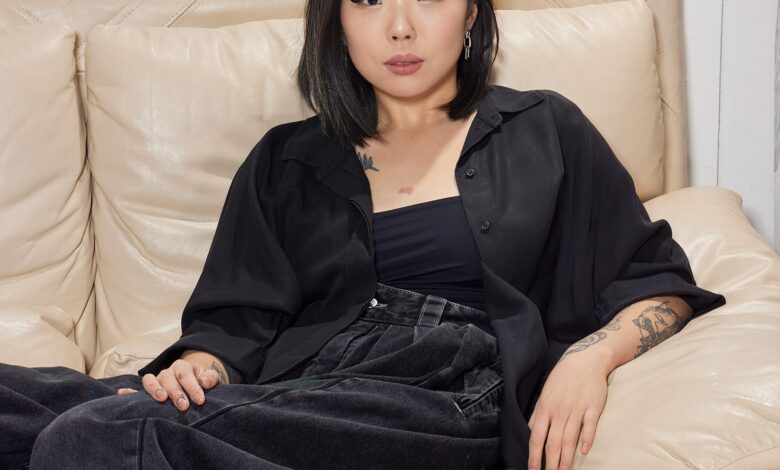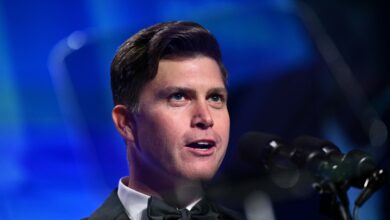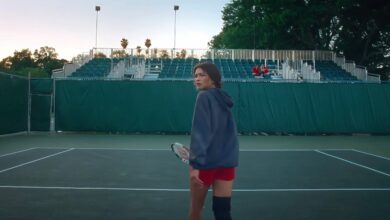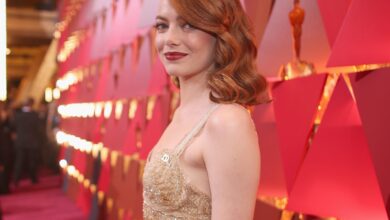Anna Park Doesn’t See Things In Black and White

As a very young South Korean-born girl growing up in Utah, Anna Park fell deeply and permanently in love with drawing. “I just found it very seductive,” she tells me. “It made me feel good.” She still feels that way. Her fluent, immersive, black-and-white images, often 10 feet long, have put her in the forefront of a cohort of Asian artists who are attracting attention from curators and collectors. Her drawings have the power and presence of oil paintings but are made from charcoal or India ink. Many of them feature the smiling, perfect young women in mid-century ads, comics, or movies, but they’re clearly not as dopey as they seem. The result is a whirlwind of abstract and figurative elements that evoke the anxieties and absurdities of popular culture in America through the eyes of someone who knows what it’s like to be on the outside looking in.
When I visit Park this past winter, her ground-floor Brooklyn studio is chock-full of works in progress for a show at the Art Gallery of Western Australia, in Perth. (It opens on today.) Park is tall and striking in her black sweater and pants, with exaggerated and expertly drawn black eyeliner and tattoos on her arms and back—a tiger, a naked lady, a foot-wide lotus, a mandala, the Roman numerals for 27, her lucky number and, as it happens, her current age. Also, an impressively coiled snake, a memento of her teenage breakup with a boyfriend.
I notice that many of the large new works in her studio include prominent text—“My pleasure!,” “Good Girl,” “Just Imagine!,” “Dangerous,” “Look, look.” It’s the first time she’s used words in her images, and there’s more than a nod to Roy Lichtenstein and Ed Ruscha—the catalog to Ruscha’s recent retrospective at the Museum of Modern Art is open on a table. “I was almost afraid to put text in my work before, because it can tend to be aggressive,” she explains. “But I feel that language is as malleable as images are, and I thought it would be interesting to play with the double entendre for certain words. It’s all about tone—the tone in which something is delivered can alter its sincerity.”
She continues, “Whenever I see large billboards of these perfectly rendered, idealized women on the side of a building, they’re all so happy or super sexy. Makeup and eyebrows and hair so kempt and curated. I wanted to make her expression at least be something more like, ‘What the fuck is going on?’ ” she says of her drawing Look, look. Her women’s expressions are sardonic, humorous, perplexed, or even slightly bilious, and all of them are versions of herself.
ATTENTION, PLEASE
Anna Park’s Look, look., 2024, is part of a new series of drawings involving text. Look, Look.: © Anna Park; Courtesy of the artist and BLUM Los Angeles, Tokyo, New York.
I also notice some intriguing source material pinned on the studio walls: an ad for a movie called Hell Baby; another featuring a small fish on a hook, hanging between two bare female legs. “It’s a French ad for tampons,” she says. Park’s pictures are “cheeky,” as she describes them. “Maybe I’m just a cheeky person, a little cornball. But it’s nice to have a layer of humor.” In an earlier picture titled First Marriage, the bride’s breasts escape from her bodice, and the groom is largely pushed out of sight. “From the moment I met Anna, I was taken aback by how kind, smart, hilarious, and effortlessly cool she is,” says the painter Anna Weyant, who was in an early group show with Park. “When I see her work, I often imagine someone laughing at a funeral.” The women in her drawings, writes Rachel Cieśla, the curator for her Perth show, are “strong female leads who might exude the confidence of Kylie Jenner or the tough charisma of Tura Satana. Mysterious and irreducible, they evoke an attitude of ‘Don’t mess with me’ but also ‘Please see me and love me.’ ”
“Wonder Women,” a 2022 group show of 40 Asian artists at Jeffrey Deitch’s galleries in New York and Los Angeles, did just that. Park’s work was one of the standouts. “It is always thrilling to see the work of an emerging artist with astonishing drawing skill,” Deitch says. “Anna is part of a dynamic community of young Asian women artists living and working in Brooklyn, a group that includes Sasha Gordon, Dominique Fung, and Amanda Ba. The emergence of these ‘wonder women’ is one of the most exciting developments in contemporary art.”
Over breakfast at E.A.T. on Madison Avenue, Park tells me her origin story. She was born in Daegu, in the southern part of South Korea, where both her parents were pharmacists. In 2001, when she was around four, her mother, Kyoungmi Jo, took her and her older brother to New Zealand. Their father stayed behind. “My mom was unconventional and adventurous,” she says. “She wanted us to learn English, but I think she also felt very trapped in Korea. The Korean school system is so intense, even from a young age. My mom wanted us, and herself, to experience something completely different, and I’m so grateful for that.” After two years, they came back to Korea, where Park started first grade, but by that time, her mother was already thinking about the United States. Within a couple of years, she moved with the two children and her husband to Redondo Beach, California. (Her parents divorced when Park was 16, but amicably.) Park spent a good deal of time watching the Disney Channel, cartoons, and movies like Mean Girls. “It was a big adjustment, and I learned quickly to pick up on people’s mannerisms,” Park says. They lived there
for almost a year, waiting for a pharmacist job to open up somewhere—that turned out to be Sandy, a largely white suburb of Salt Lake City, where Park finished elementary school and went to middle and high school. “I hated that people would gawk at the food I’d bring to school, my stiff black hair and Asian features, my insecurity with the language,” she says. “For so long, I really wanted to be just a blonde white girl.” One of the new works in her studio, Picture That, includes a cropped word, “blonde.” “It’s the perspective of my childhood self,” she says, “which was trying to peer beyond the edge of this identity that I could never attain.”
Drawing was her main consolation and support: “I was known at school as that weird girl who likes to draw.” Park entered local art competitions, and after spotting one of her drawings at the mall, a man named Bruce Robertson called her mother. He ran an after-school art program, and Park started taking classes there when she was in the fifth grade. “He really took me under his wing,” she says. “I ended up going there every week.” This is where she started drawing with charcoal. “That’s how he taught everybody. It was very classical training, and he was very honest with me. He wasn’t sugarcoating anything. A lot of times I was just frustrated to tears because I wanted to be great at the thing
I loved doing. He instilled the idea that you have to put in the hours to get where you want to go.”
When Park was 14, a family trip to New York opened new horizons. “We did all the quintessential New York things—double-decker bus tour, Statue of Liberty, The Phantom of the Opera on Broadway, The Metropolitan Museum of Art, and the Museum of Modern Art. I remember telling my mom, ‘I’m going to live here one day.’ ” When it was time for college, Park ended up at Pratt Institute in New York. “For the first time in my life, I felt like I wasn’t so different, that I just blended in,” she says. “I was high on life, and I felt comfortable with myself. It took me such a long time to get to the point where I was proud to be Korean.” She knew her mother worried that she might never be able to support herself as an artist, and she was very aware of not taking anything for granted. “I was like, I have to make something out of myself, to make it worthwhile for my mom to have sent me here.”
Anna Park, First Marriage, 2021. First Marriage: charcoal on paper on panel, 60 x 72 inches. © Anna Park; Courtesy of the artist and BLUM Los Angeles, Tokyo, New York.
After two years of Pratt’s four-year program, though, Park dropped out. She loved the school because “it was so open to what I wanted to do, but I needed more structure.” She went directly to the New York Academy of Art, a private graduate art school in Tribeca. “It was a very traditional painting and drawing program, and maybe because of my roots with Bruce Robertson, this was where I wanted to go.” She didn’t have an undergraduate degree, but after a year there, she could apply for the two-year master’s program, and that’s what she did, more or less. She skipped most of her classes so she could spend all her time in her studio. “I just wanted to make my own stuff.”
Her professional career started while she was still in school, in 2019. The academy was honoring the wildly popular artist known as KAWS (Brian Donnelly) at its annual Tribeca Ball, when the students open their studios and everyone is invited in to see their work. KAWS was so struck by Park’s drawings that he bought one on the spot, and posted her work on Instagram. (He has 4 million followers.) “I knew about his work, but I didn’t know I was talking to him,” she remembers. “I asked him, ‘Do you do art?’ ” When she found out he was that night’s honoree, “I was so mortified. He was very sweet about it. And that’s how everything exploded.”
“Two First Names,” a show with Ana Benaroya at Garey Gallery in Los Angeles, quickly followed, and all four of Park’s drawings in it were sold. A passel of group shows in New York then took place, and there were solo shows, too—at Half Gallery in New York, and at Blum & Poe, first in Tokyo in 2021 and then in Los Angeles. (She has since joined the gallery, now Blum without the Poe.) And then in 2022, she had her first solo museum show at the SCAD Museum of Art in Savannah.
The works in her new show are three-dimensional. Tired of people asking if her drawings are preparations for paintings, she turned her surface into a relief by cutting squares and arches into a sheet of two-inch-thick insulation foam, which she glues on top of a thick wood panel. She then covers the whole surface with rice paper and draws on that. The work becomes an object. “There’s a stubbornness in me,” she says. “I love drawing to the deepest of my core. If something is on a panel or canvas instead of paper, people say, ‘Oh, it’s art now.’ People call these paintings.” But what does she call them? I ask her. “I call them drawings. Let’s celebrate it!” Does she see herself making sculpture? “That’s a goal that I’m inching toward,” she says.
Park gets to the studio around noon and works until midnight or later—she turns her phone off and locks it in a box while she’s there. Her apartment is nearby and she’s in bed by two in the morning, unless she goes out to Bushwick’s clubs. “I love dancing, but it’s all sober dancing. I don’t really drink. And I just love listening to music.” She also enjoys going out for dinner with the painter Sasha Gordon or other artist friends. Park recently broke up with the artist boyfriend she’d been with for three and a half years. Alone in the studio, she likes to have something going on in the background, but usually not music. She listens to a lot of comedy podcasts (she lists Las Culturistas by Bowen Yang and Matt Rogers, and SmartLess by Jason Bateman, Sean Hayes, and Will Arnett) and loves stand-up comics. “That’s one of the hardest professions because it’s a combination of timing, writing, and performance, and then you have no control over the audience.” She also listens to audiobooks, and her taste is eclectic—she’s recently listened to Yellowface by R.F. Kuang, Killers of the Flower Moon by David Grann, The Bell Jar by Sylvia Plath, and the Britney Spears memoir. And she’s a big fan of familiar TV shows, like Gilmore Girls, which she watches often. “It can’t be a show that’s too good or a show I’ve never seen before.”


